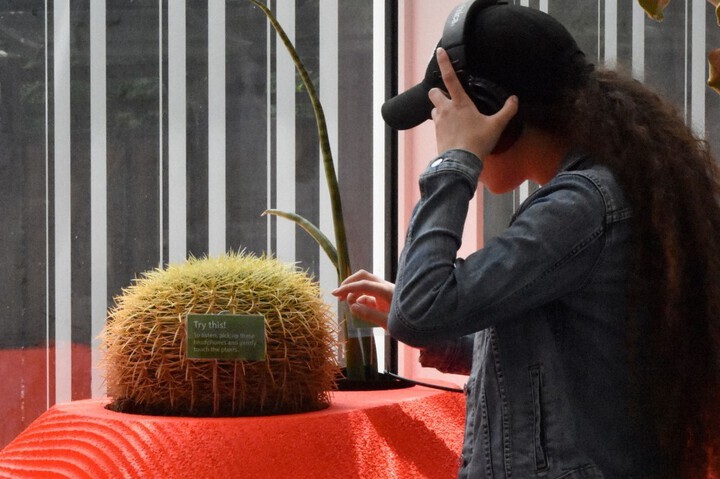What does a cactus sound like when you pluck its spines? Or tap its stem? What would make you even try to find out?
For her work Sonic Succulents: Plant Sounds and Vibrations, artist Adrienne Adar has attached handmade sensors to 21 potted succulent plants displayed in Brooklyn Botanic Garden’s Visitor Center. Visitors can put on headphones and then prick, tap, rub, or drum upon each one to produce a range of sounds from twangy, banjo-style plucks to mellow, ethereal humming. The subtle sounds that the plants make as they grow and transpire are also amplified.
Adar recently talked with Brooklyn Botanic Garden staff about her work and what inspired it.
Q: It’s unusual to see live plants used in art at all, let alone in an interactive or sound-based piece. What made you think of combining all these elements?
A: I’ve always had a lot of questions about our relationship to nature. For instance, why do we think of plants differently when they are part of the environment versus when they’re a commodity, like a houseplant for sale in a store? As a sound artist and photographer, I’m also really interested in all the different structures and shapes of plants.
Did you grow the plants?
No, I sourced them from a nursery that specializes in succulents from the Mojave Desert, but it’s funny you asked that. At an earlier exhibit with similar cacti, people kept coming up to me asking things like, “How did you make them so realistic?” and “What are the spines made of?”
I guess seeing them in a botanic garden made me realize they were live plants. On the other hand, they are displayed as sculptures would be.
Exactly. Part of what I want to do is challenge people’s assumptions and ask them to take some risks. First, you don’t really expect to touch art. And second, you don’t really expect to be able to touch plants displayed in a botanic garden, let alone be encouraged to do so.
Especially not cacti! They’ve evolved to be untouchable.
Yes, but I want to cultivate careful, respectful interactions with plants. I think some people will choose to wait and watch someone else touch one first in order to feel ready. Or maybe they’ll need to read a little bit about the exhibit first. If people have to get over something, some discomfort, to interact with them, it can make their experience more meaningful.
So if you touch a cactus consciously and carefully, you’ll probably have a positive experience. But if you take your eyes off of the plant, maybe turn your head and start talking to your friend—ouch! You might get pricked.

Why have visitors wear headphones instead of broadcasting the sounds on speakers so everyone around could listen together?
I didn’t want to just have people hear sounds. That would be a different type of exhibit, more like a performance. Here I wanted to give them the experience of creating their own sound. This is also a way of asking people to really focus and listen to living things that are seemingly silent.
Sonic Succulents: Plant Sounds and Vibrations will be on view at the Visitor Center and elsewhere in the Garden through October 27.